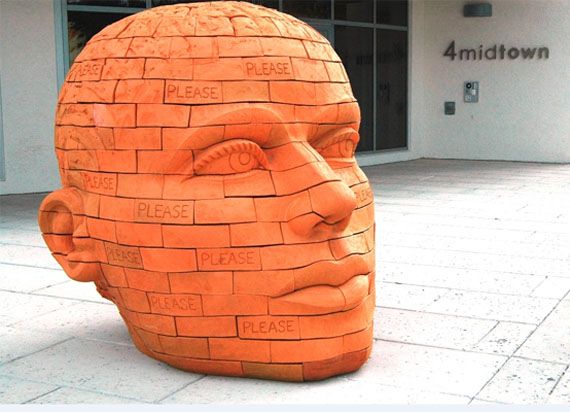
Photo Credit: Brickhead Please Stop by James Tyler
A dozen upright pianos play peek-a-boo in Miami’s public spaces, sprouting wings and sporting the words "Bling-Bling" above googly-eyed cartoon faces. Next-level graffiti goes three-dimensional in the Midtown Rotunda — one single piece towering 30 feet high, crafted from 12,000 fragments of contemporary furniture. The Miami Airport has given one of its main passenger walkways to an interactive audiovisual installation entitled "Harmonic Convergence." It looks like a rainbow tunnel and sounds like the Everglades.
Miami Art Week is back and it’s bigger, weirder, gaudier and more fascinating than any tabloid or socialite coverage might suggest. While most people are only vaguely familiar with the jet-set Vogue-favored social scene of Art Basel, this is actually a vibrant, city-wide affair that encompasses a dozen art fairs and has transformed Miami into a breeding ground for contemporary art.

"Miami is a young, fresh, gritty community," says gallery owner Fredric Snitzer, who has been involved with Art Basel Miami Beach since its inception and is presently the only Miami-based member of the Basel selection committee. "It’s a complicated community of visual arts associates."
Asked to elaborate on just what "complications" made Miami so appealing that, 10 years ago, the famously jaded contemporary art elite passed over all other U.S. cities to anoint it the wintertime counterpart to Art Basel in Europe; Snitzer says succinctly, "It’s politically complicated, scratching to become noticed, and culturally extremely diverse."

Just 15 years ago, the creative works most strongly associated with Miami were the cop drama Miami Vice, the underworld epic Scarface and Will Smith’s hit single "Welcome to Miami." Half retirement destination, half Latin American expat hangout, the city would never have made it onto anyone’s list of United States cultural hubs. But beneath the South Beach revelry and the disco-samba was a small but growing community of international art collectors who were inspired to base their collections in its vast, empty industrial blocks and tucked-away tropical haciendas. It was simultaneously welcoming an influx of young creatives from Cuba and Puerto Rico and further-flung South American locales.

"The visual arts community was evolving in the late 90s and began to have a strong life of its own. The Rubell Family Collection set up shop, Marty Margulies opened to the public, and the Museum of Contemporary Art North Miami started showcasing the local artist community," remembers Snitzer. "Basel was looking for a winter venue, a counterpoint to the long-established art fair in Basel, Switzerland...and all of this made Miami seem like an interesting kind of place for a counterpoint affair."
The first Art Basel Miami Beach was held in 2002, and since then, a dozen other events have begun to occur in conjunction, including SCOPE Miami and Design Miami. Blue chip artists and billionaire collectors coexist with unknown artists and groupies who hitch-hike to Miami just for the parties. And perhaps because the whole scene is so new and rough around the edges, there’s not much of a hierarchy.

"We have worked with several established galleries and artists, and it’s always been positive," says Herman Leyba, whose Ideobox Artspace has participated in Miami Art Week since opening in 2008. "It’s great to be able to exchange with traditional and established galleries and artists."
Though the list of names and brands participating in Miami Art Week features one bold name after another (works by Damien Hirst at the Fountainhead Residency; Philippe Starck collectibles in the "Liberty, Equality and Fraternity" exhibition at the Wolfsonian; hip-hopper Nas performing live at the Spotify "Music Loves Art" party featuring works by James Franco), the masterminds behind Miami Art Week almost seem to dismiss the socialite, celebrity element.
"Maybe 1500-2000 people participate in the parties," estimates Fred Snitzer. "But the celebrity, party atmosphere is really only skimming the top of the event. The core is a really huge audience of people interested in looking at contemporary art."

Colombian artist Rodrigo Echeverri typifies the Miami Art Week mindset. Gearing up for his first-ever U.S. solo exhibition at Ideobox Artspace, while simultaneously prepping a piano for the public art installation Popup Pianos, Echeverri seems almost more excited about painting a piano for a non-profit than being seen by big-money collectors.
"I thought it was great. My work is not related, but it’s another way to express a new idea," he says. "Some people don't go to museums or to galleries, and when you put art in the public spaces and the street, it gives them a great opportunity to experience it."
On the eve of the 10th anniversary of Art Basel Miami Beach, there’s no doubt that artists like Echeverri are playing for much higher stakes than mere public enrichment. Careers are made at Miami Art Week. However, the city’s rapid metamorphosis from seedy beach playground to international art capital creates a different canvas for an artist who wants to play here. It’s ready for anything, in any neighborhood. From Midtown to South Beach to the airport, Miami welcomes whatever is new and exciting. It’s up to the attendees to determine what’s best.









